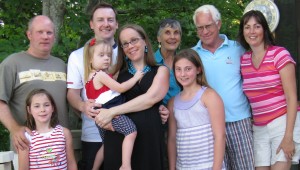Faculty Profile: Richard J. Santen

Richard Santen and family
Dr. Santen joined the Endocrinology faculty at UVA in 1996, after serving as chief of Endocrinology at Penn State, Hershey, and as chair of the Department of Medicine at Wayne State University Medical Center in Detroit.
What excites you about your work?
Meeting interesting individuals as patients and having a unique window into their lives. When this is combined with testing new therapies, the bond between patient and physician can become rather deep.
Why research?
The chance to develop new treatments for my patients. As our knowledge advances, so does the ability to improve their quality of life. And engaging in rigorous scientific research while providing patient care is highly satisfying.
What brought you to Charlottesville?
Bob Carey, Mike Thorner and John Marshal were looking to recruit an endocrinologist with expertise in hormone-dependent cancer. Ed Hook, former chair of the Department of Medicine, had been my attending at New York Hospital while I was an intern there, so I had a long-time interest in coming here.
Most admired person?
My earlier mentor, C. Alvin Paulsen. He was a real “mensch,” with wide knowledge and superb judgment, empathy for his patients, and deep care for those he worked with.
Best advice you ever got?
“Study aromatase.” Pentii Siiteri gave me this advice, and it proved to be the key to treating hormone-dependent breast cancer—and the focus of my research career.
Proudest achievement outside the professional realm?
Convincing my wife, Kathy, to marry me; raising our three children; and receiving the 2012 Sanctae Crucis alumnus award from my undergraduate college, Holy Cross. [see sidebar]
What’s next?
I’ve built an office in my summer home at Smith Mountain Lake that has teleconferencing capability. I plan to take care of patients with diabetes in rural areas by telemedicine. This will be a way of continuing to practice medicine, even in “retirement,” and provide much-needed care to people in underserved areas.
– Medicine Matters, 11/6/13
